Why can’t I access this file?
Possible reasons you cannot access this file:
- Your membership has expired.
- The file is restricted to certain users.
If you are seeing this message in error, please contact us.
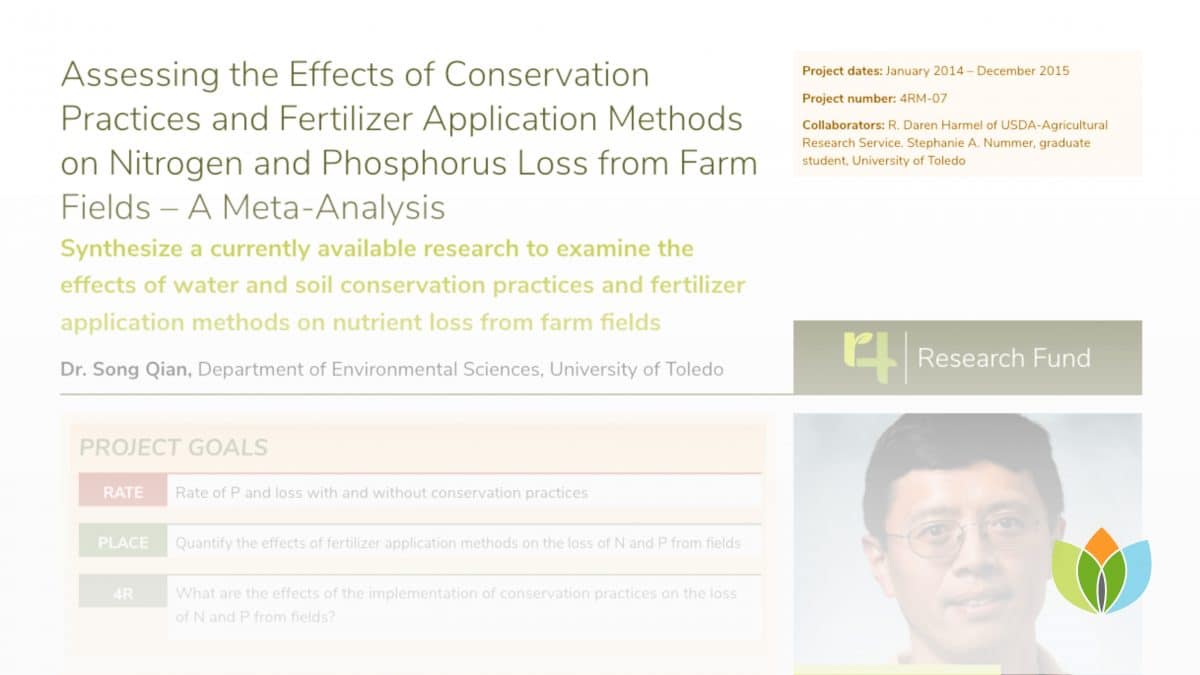
Crops: Corn for grain Corn for silage Cotton Hay Potato Rice Rye Ryegrass Sorghum Soybeans Sugar beets Sugarcane Winter wheat Wheat
4R Practices: Metadata Project

Lead Researcher:
Dr. Song Qian
Associate Professor
University of Toledo
Start Date: 2014
End Date: 2016
The project augments an existing database by (1) revising studies included in the existing database to update information about fertilizer application methods, as well as additional variables, and (2) updating the database with recent studies. The project documents the use of the propensity score method and the multilevel modeling approach in the context of meta-analysis. Results are applicable for improved assessment of agricultural practices and their effects on the environment and can be used for providing realistic parameter values for watershed-scale modeling.


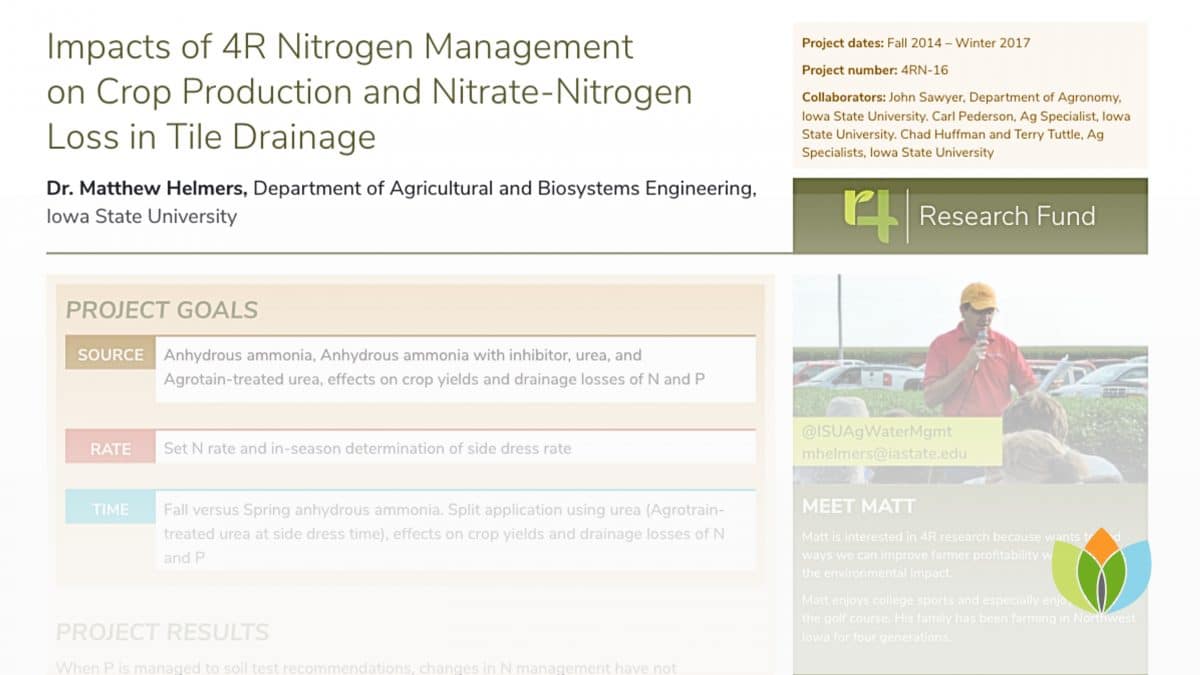
Crops: Corn for grain Soybeans
4R Practices: Source Rate Time Place

Lead Researcher:
Dr. Matthew Helmers
Director, Iowa Nutrient Research Center and Dean’s Professorship in the College of Agriculture and Life Sciences
Iowa State University
Start Date: 2014
End Date: 2017
Corn and soybean producers in Iowa and throughout much of the U.S. Corn Belt are increasingly challenged to maximize crop production to supply feed, fiber, and more recently biofuels (especially ethanol from corn) while at the same time managing soils by utilizing fertilizers and animal manures efficiently and minimizing negative impacts on water quality. In particular, there is concern about nutrient export from subsurface drainage and surface water runoff to water systems in Iowa and the Gulf of Mexico. In addition to local impacts on receiving waters, nitrogen (N) and phosphorous (P) loads from U.S. Corn Belt are suspected as primary drivers of hypoxia in the Gulf of Mexico. The EPA SAB’s 2007 hypoxia reassessment identified both N and P as major contributors to Gulf hypoxia and the 2008 Action Plan called for a dual nutrient strategy of 45% reductions in both N and P loads. Relative to N loss, nitrate‐N is the predominant form in many agricultural watersheds due to subsurface drainage or shallow subsurface flow. Nitrate‐N loading from the Mississippi River is suspected to be a main contributor to the hypoxic zone in the Gulf of Mexico, and the main source of nitrate‐N in the Mississippi River Basin has been linked to subsurface drainage in the Midwest. Based on the need for nitrate‐N reductions to meet water quality goals, new management practices are needed that have the potential to significantly reduce nitrate‐N losses at minimal cost and/or provide economic benefits. Practices are needed that will address the right source at the right rate in the right place. In addition, there is a need to quantify the water quality and crop yield impacts of some traditionally recommended best nutrient management practices such as timing of N application The Iowa Nutrient Reduction Strategy Science Assessment has indicated nitrate‐N loss improvement with certain practices, such as time of application (spring versus fall) and nitrification inhibitor. However, the published data available for the science assessment was limited for those practices, especially from Iowa research. Also, the practice of split or in‐season application had indication of limited benefit to tile drainage nitrate‐N reduction. Among other practices, the Iowa Nutrient Reduction Strategy specifically identified in‐season sensor‐based nitrogen application and nitrogen inhibitors needing of future research that would concurrently document crop production and water quality (nitrate‐N loss) effects.




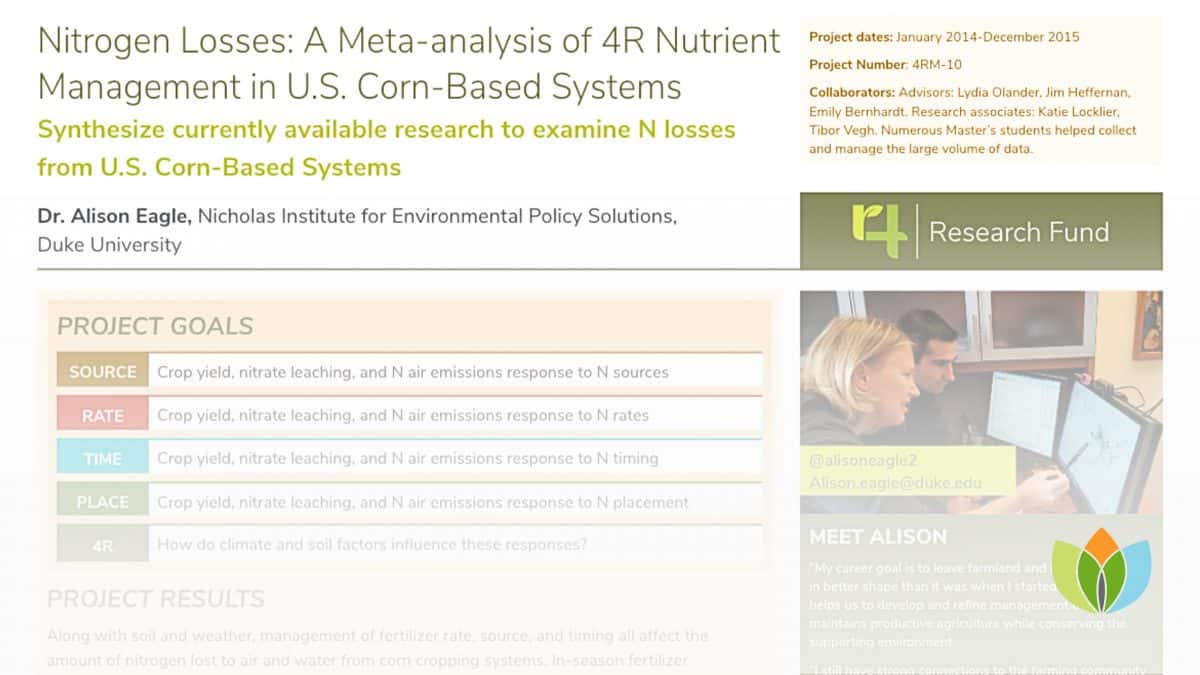
Crops: Corn for grain
4R Practices: Metadata Project
Lead Researcher:
Dr. Alison Eagle
Scientist
Environmental Defense Fund
Start Date: 2014
End Date: 2014
Modern fertilization practices have fed the world, but unfortunately, they also contribute to serious environmental consequences – coastal dead zones and fish kills, acid rain, climate change, and stratospheric ozone destruction. These result most notably from nitrate (NO3) leaching and runoff, and nitrous oxide (N20) emissions coming from nitrogen (N) not taken up by crops. Improved fertilizer management is vital to efforts that seek to increase cropping efficiency and minimize these nutrient losses. Such improvements can enhance both farm profitability and environmental sustainability. Many studies have evaluated responses of yield to varying fertilization rates, some have measured losses of NO3 and a few have included N20 , but rarely have they considered these all together, and not in a way that accounts for multiple aspects of proper nutrient management or how these relationships vary with soil, climate, or crop type. A meta‐analysis of existing research would allow evaluation of many of these relationships and significantly enhance our understanding of what is controlling N use efficiency (NUE) and N loss pathways.
Answering these questions in a comprehensive and integrating manner will provide novel, region‐specific information that can be used to 1) estimate the magnitude of reduced fertilizer needs and reduced excess N under different scenarios of 4R management, 2) estimate the magnitude of NO3 and N2O losses under different scenarios of 4R management, 3) invest limited research dollars more strategically and 4) implement N management in ways that maintain or improve yields while minimizing environmental costs.


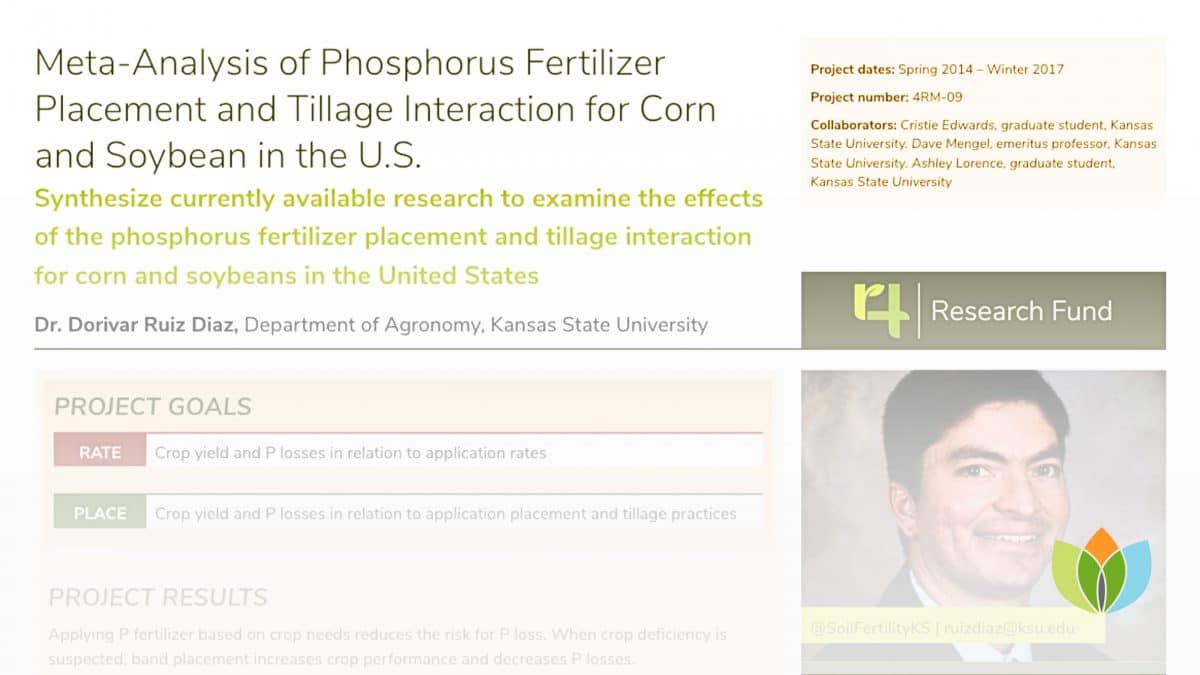
Crops: Corn for grain Corn for silage Soybeans
4R Practices: Metadata Project

Lead Researcher:
Dr. Dorivar Ruiz Diaz
Professor
Kansas State University
Start Date: 2014
End Date: 2015
Phosphorus placement and interactions with tillage has been evaluated extensively for corn and soybean in the US. Results suggest that placement of P fertilizer can play an important role in early P plant uptake and yield as well as potential P loses to surface water for some soils and tillage conditions. The rate of P uptake per unit of root in corn decreases throughout the vegetative growth phase; and therefore early season P fertilizer applications and placement can be particularly important for optimum plant growth. Broadcast application can result in a more uniform distribution and likely affecting more soil volume. Crops have shown a response for various levels of soil test, including low soil test P (STP) conditions and medium to high STP. However, accumulation of P near the soil surface may result in higher lost potential with runoff; and possible decreased P availability due to increased soil-fertilizer interaction in soils with high P sorption capacity. Broadcast application may be more practical for some producers and suitable for some soils and tillage conditions. However, soils and tillage conditions and the interaction with P application methods should be evaluated with larger datasets and across different soils and environments. Potential P loses with water runoff can be affected significantly by phosphorus placement and tillage. Many studies in the US evaluated water runoff and P loses as affected by tillage and fertilizer. However studies often show different results, which may be due to differences in soils, rainfall amounts and intensities, slope, moisture content, and infiltration rate. Evaluation and summary of the existing literature can help to identify factors contributing to potential P loses in addition to tillage and fertilizer placement. Crop response and P loss potential can be affected by the interaction between soil and tillage factors with P fertilizer placement. Accurate evaluation of these interactions would require large dataset that comprise a variety of soils, tillage and placement combinations.



Crops: Canola Corn for grain Corn for silage Cotton Hay Potato Rice Ryegrass Sorghum Soybeans Sugar beets Sugarcane Winter wheat Wheat
4R Practices: Metadata Project
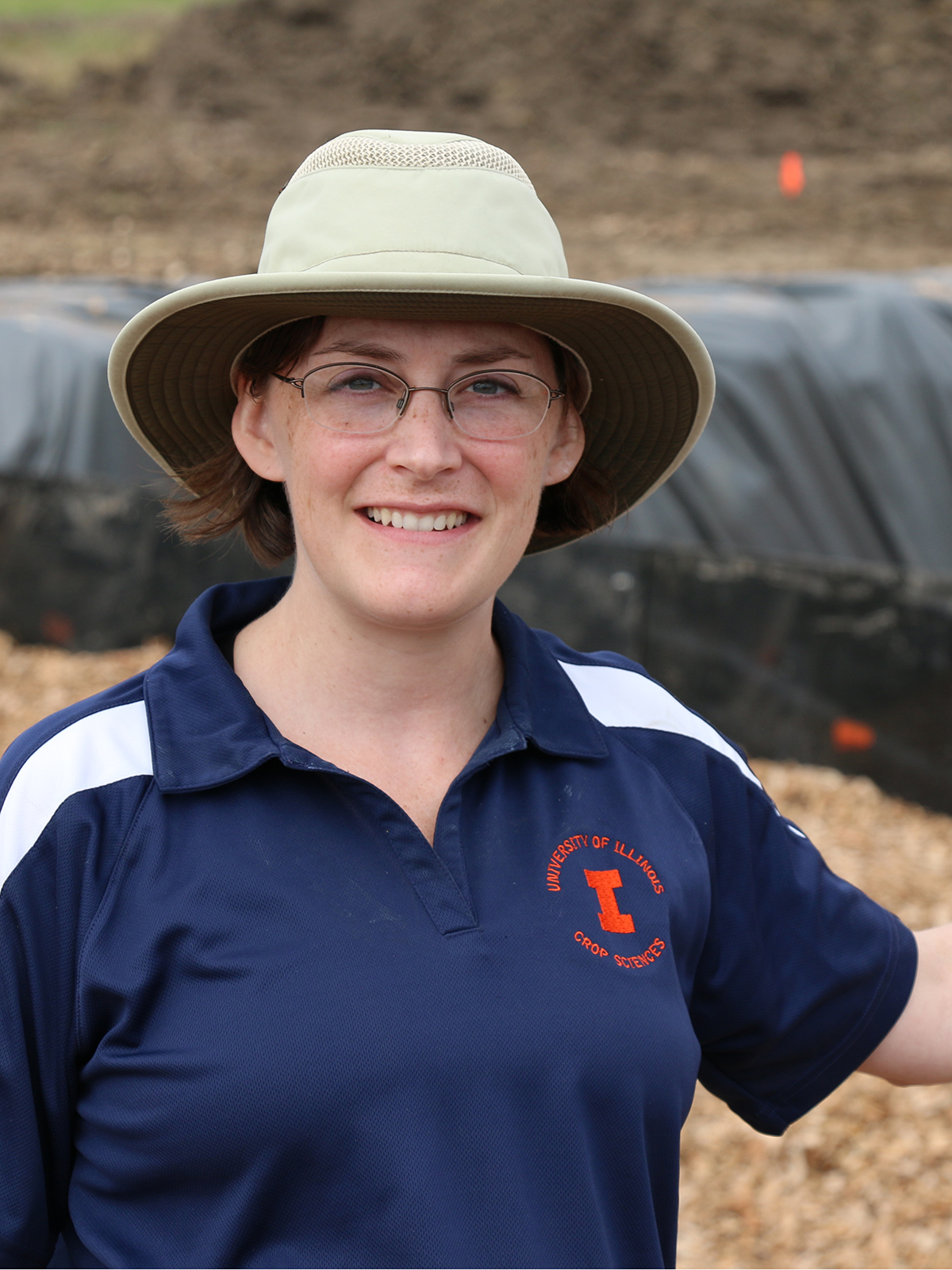
Lead Researcher:
Dr. Laura Christianson
Assistant Professor
University of Illinois
Start Date: 2014
End Date: 2015
As agriculture in the 21st century is faced with increasing pressure to reduce negative environmental impacts while continuing to efficiently produce food, fiber, and fuel, it becomes ever more important to reflect upon more than half a century of drainage water quality research to identify future paths towards increased sustainability. This work provided a quantitative review of the water quality and crop yield impacts of artificially drained agronomic systems across North America by compiling data from drainage nutrient studies into the “Measured Annual Nutrient loads from Agricultural Environments” (MANAGE) database. Of the nearly 400 studies reviewed, 91 individual journal publications and 1279 site-years were included in the new MANAGE Drain Load table with data from 1961 to 2012.

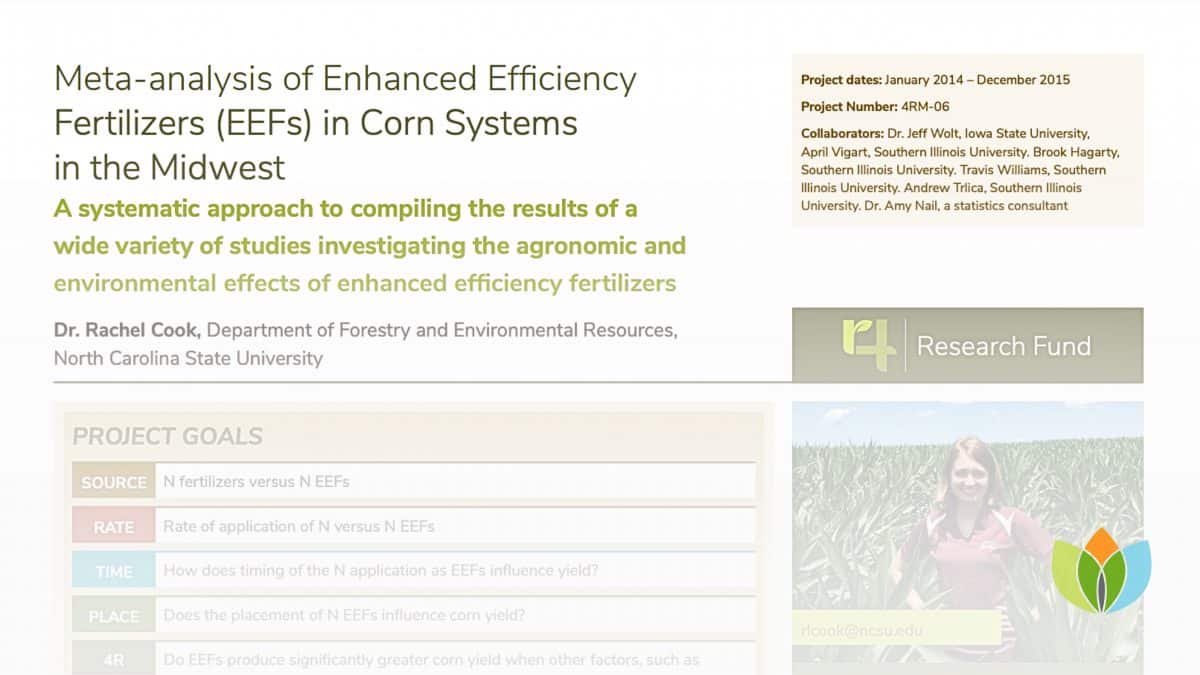
Crops: Corn for grain Corn for silage
4R Practices: Metadata Project
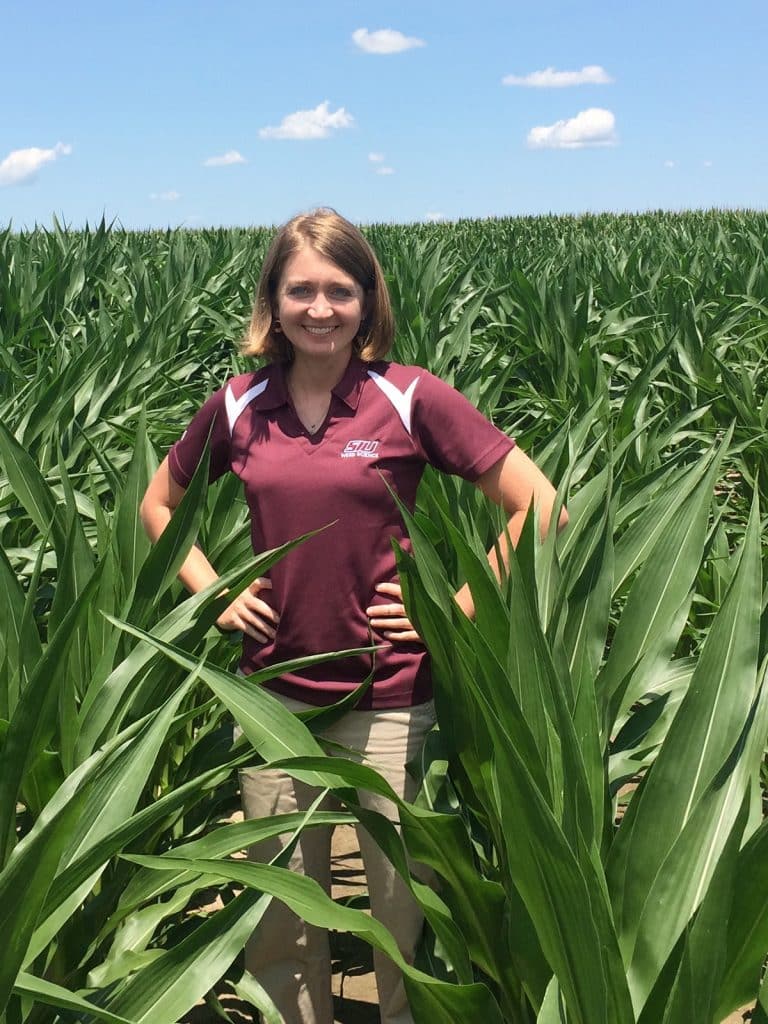
Lead Researcher:
Dr. Rachel Cook
Assistant Professor
North Carolina State University
Start Date: 2014
End Date: 2015
The 4R approach to nutrient stewardship has helped develop a better context for driving best management practices in production agriculture. As the agricultural community becomes more involved in exploring the three aspects of sustainability, including the economic, social, and environmental triple bottom line, the 4Rs (right source, right rate, right time, and right place) provide a framework for better management of fertilizer applications.
The exceedingly large number of possible combinations of source, rate, time, and place, even within one cropping system, can make it difficult to compare results from studies located in different regions, with different climate, soils, and accepted management practices. To prevent needless duplication of study parameters and suggest future study directions, the soil fertility and fertilizer community needs to systematically compile what we know in order to move forward in the most efficient manner possible.



Possible reasons you cannot access this file:
If you are seeing this message in error, please contact us.
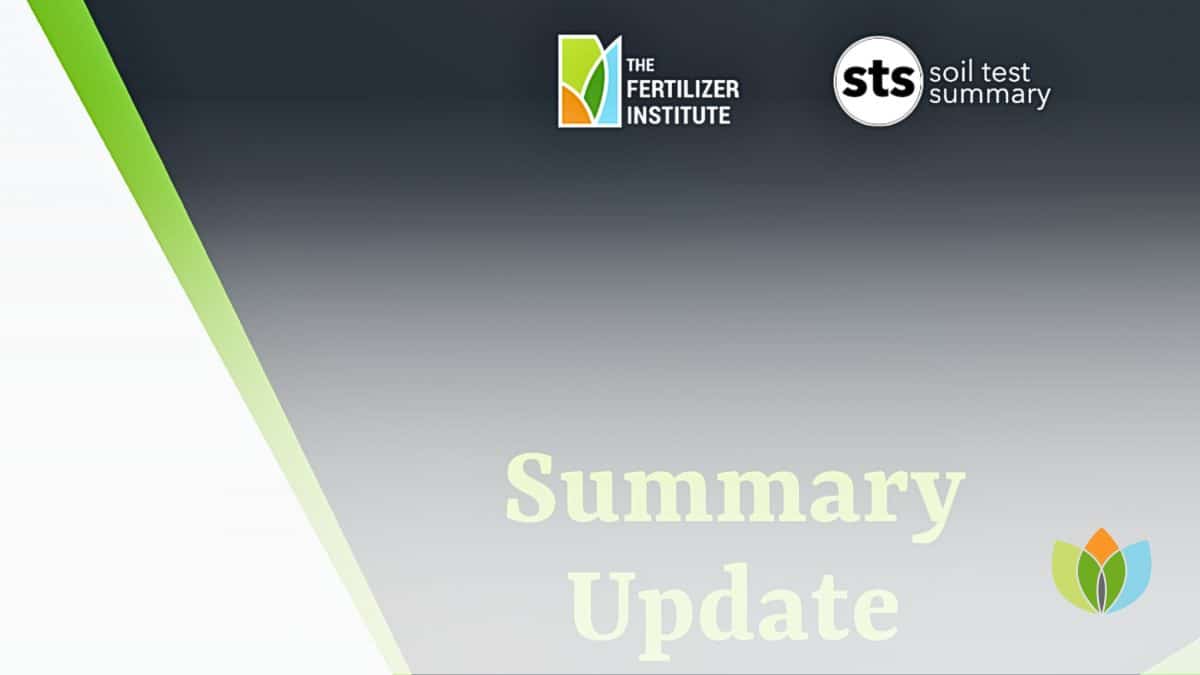
Possible reasons you cannot access this file:
If you are seeing this message in error, please contact us.


Possible reasons you cannot access this file:
If you are seeing this message in error, please contact us.